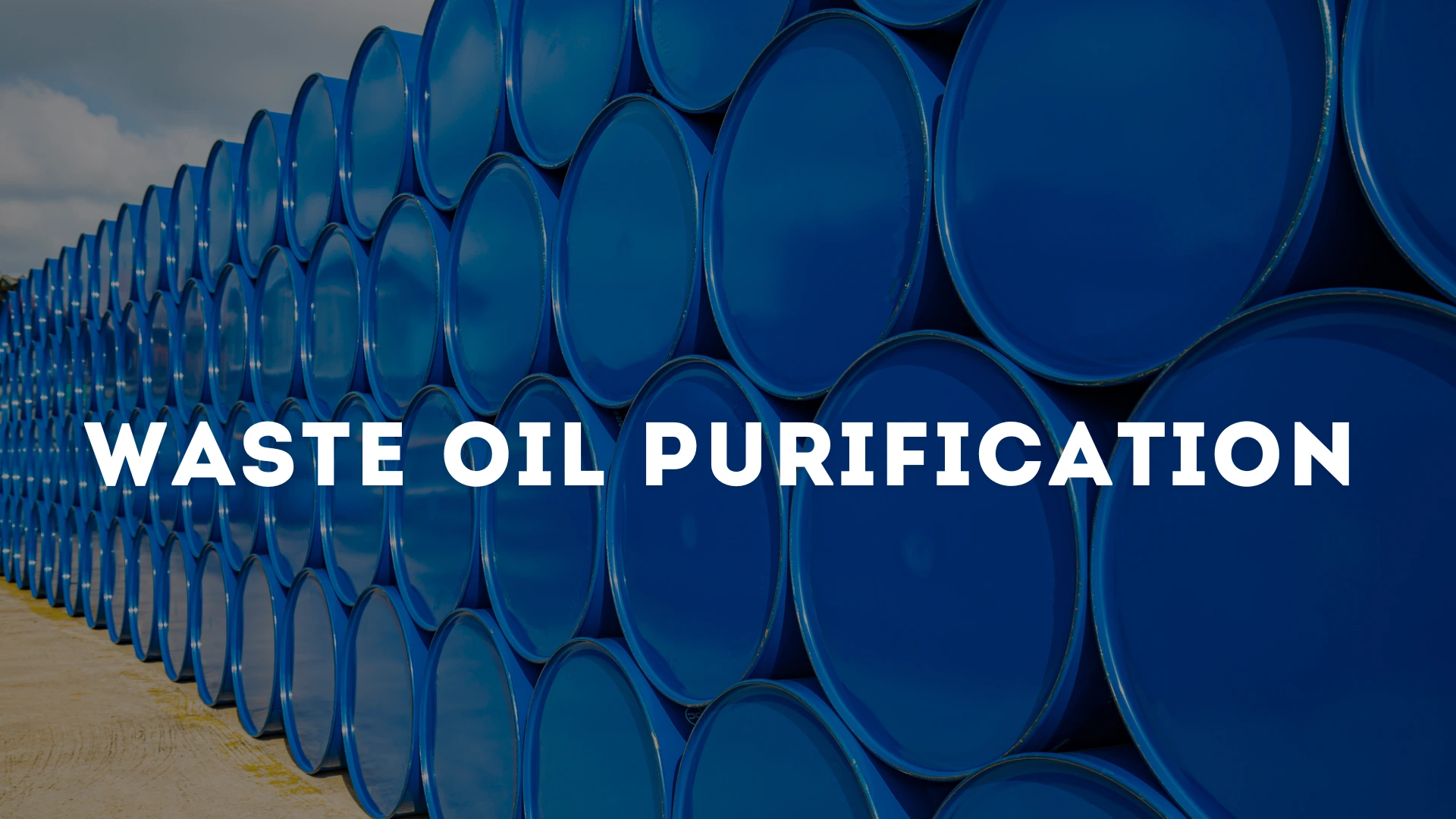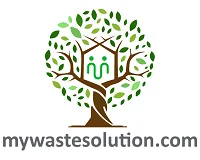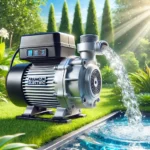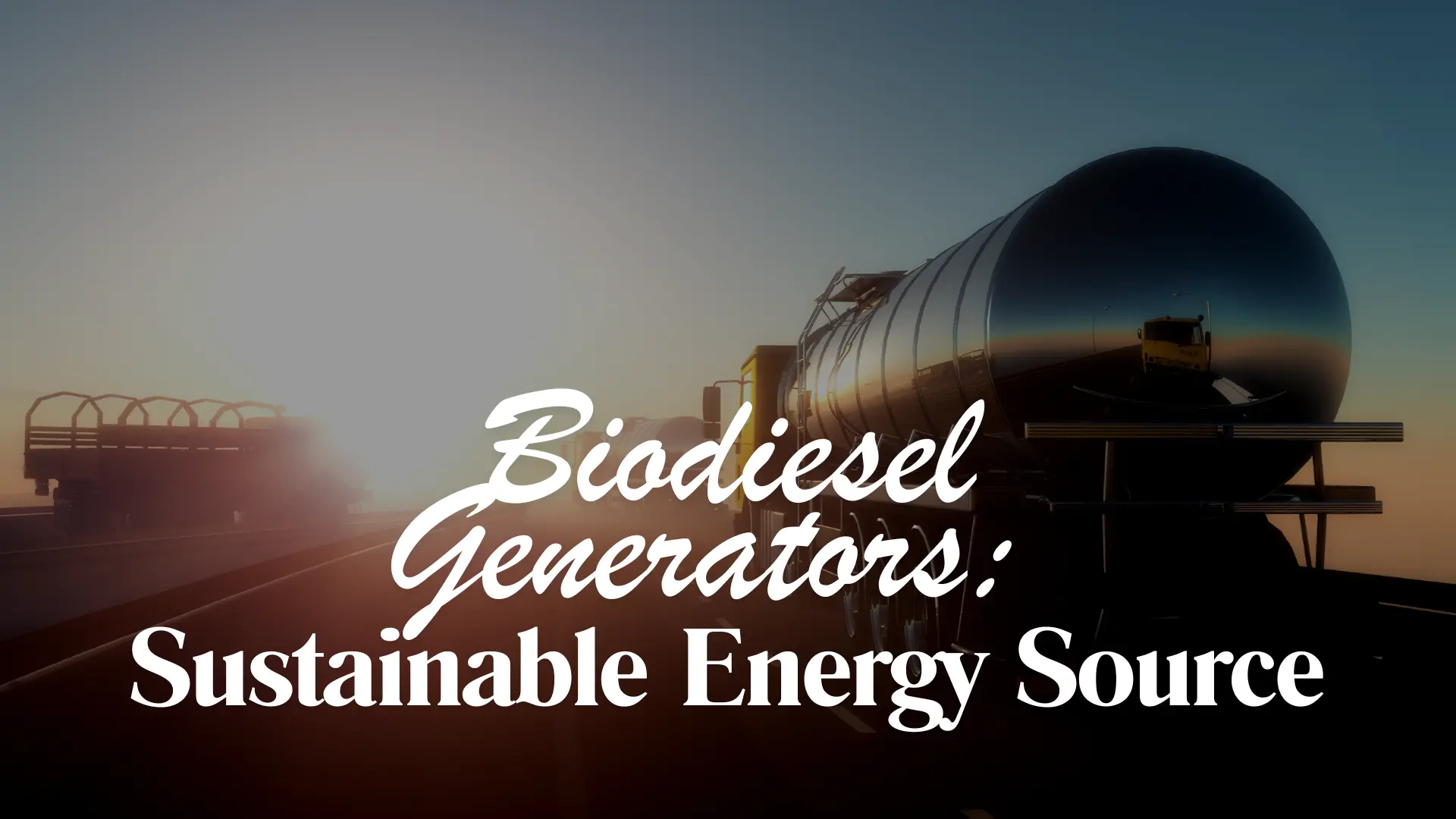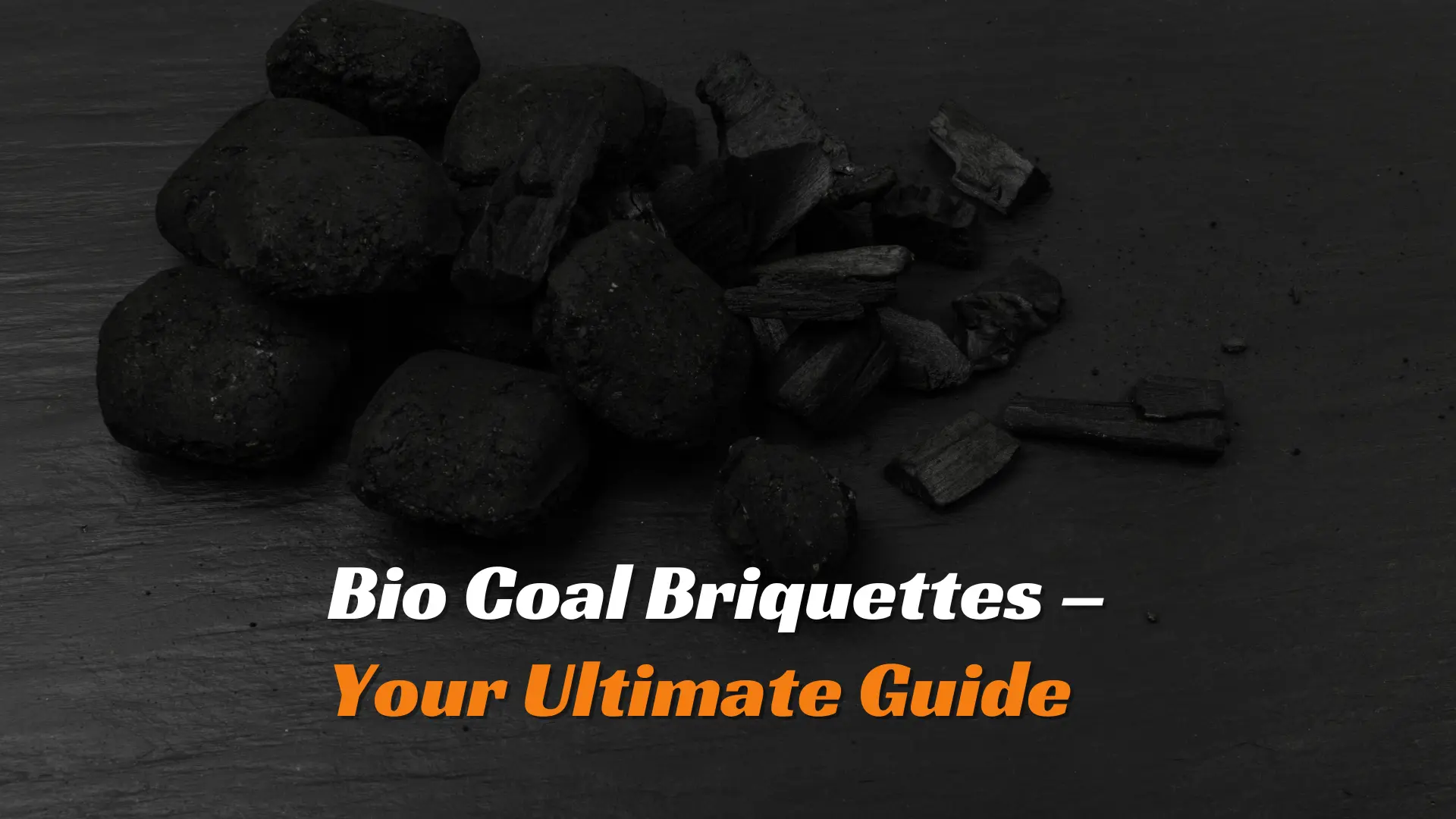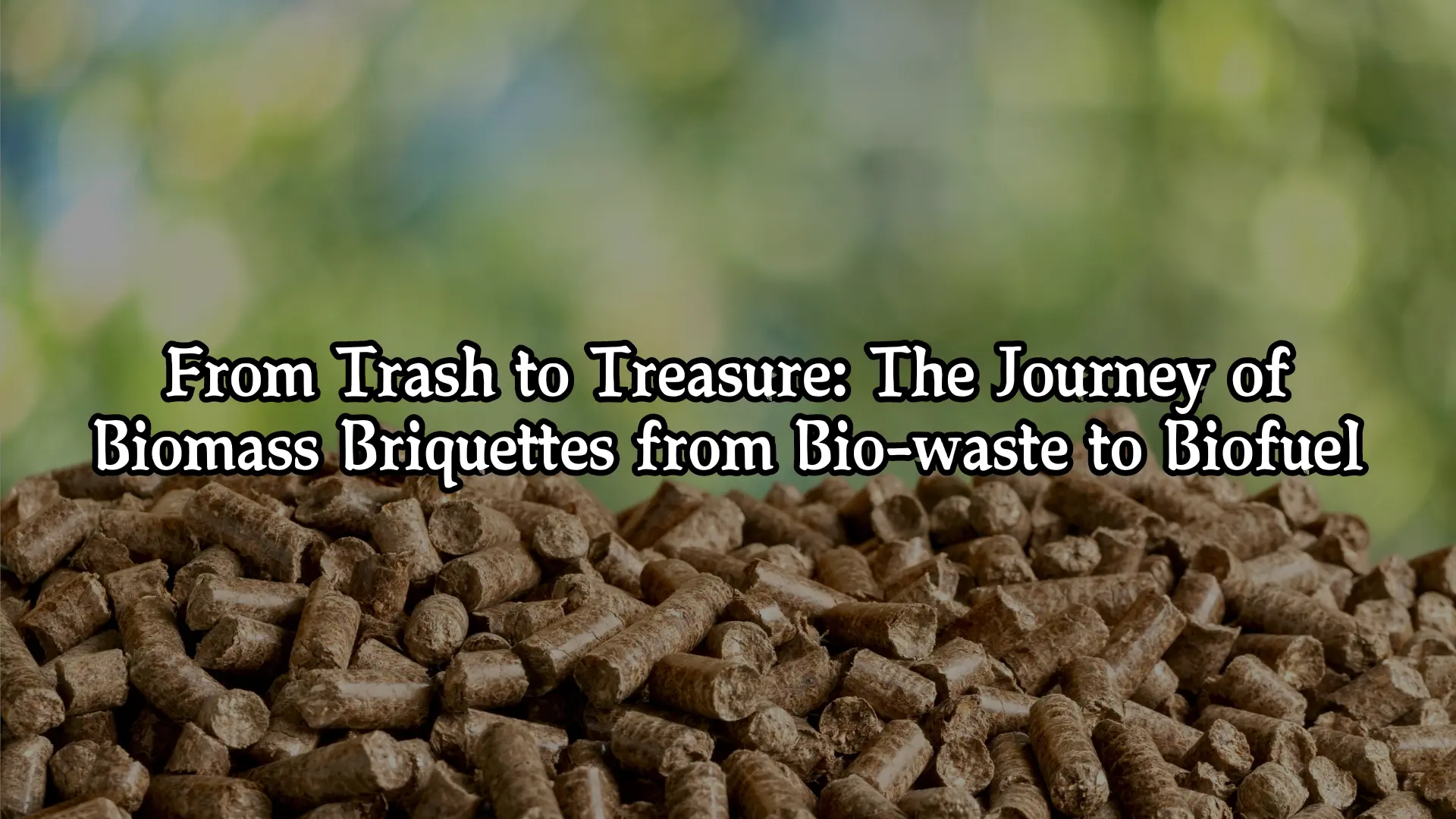1. Introduction
Every year, vast amounts of used oil are improperly disposed of, contaminating lakes, rivers, oceans, and groundwater, which threatens both the ecosystem and public health. Fortunately, waste oil purification offers an effective solution. This process eliminates harmful substances, extending the lifespan of the petroleum for reuse as fuel-based products. Practiced globally, the treatment of waste oils is technically feasible and essential for environmental protection. Used oils, such as sludge, cooking fats, engine lubricants, and hydraulic fluids, contain hazardous materials that, if untreated, pose significant ecological risks. This blog will explore the various types of recycled oils and their respective purification methods.
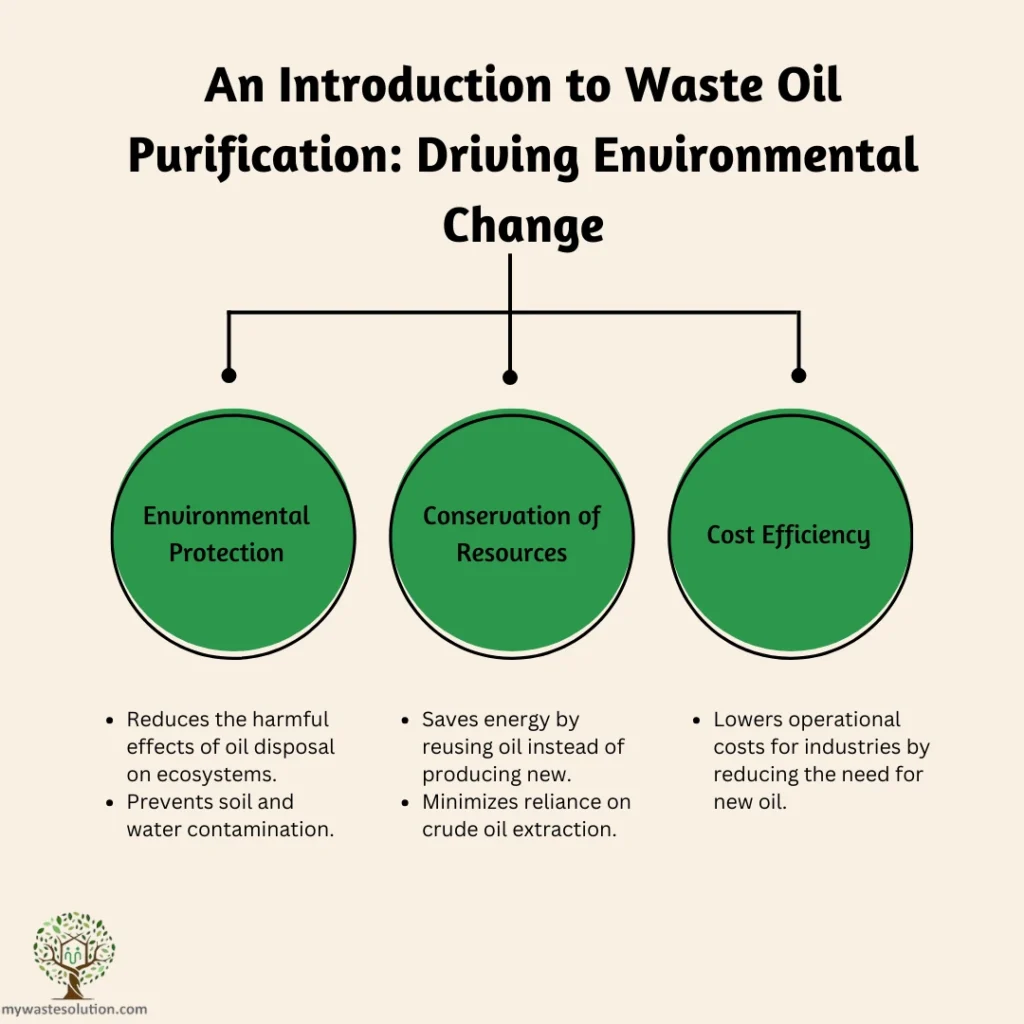
2. Waste Oil Purification Overview
2.1 Methods for Waste Oil Purification:
In waste oil purification, various physicochemical techniques are employed to efficiently cleanse the fluid. These techniques effectively eliminate suspended particles and contaminants, making the oil suitable for reuse or safe disposal. Moreover, this method minimizes environmental impact and significantly improves the overall effectiveness of lubricant recycling.
2.1.1. Physical method :-
In the physical approach, we employ processes such as sedimentation, separation, filtration, and distillation to extract solid impurities. Additionally, we utilize water washing to remove moisture-related contaminants, ensuring that we achieve cleaner, reusable fluids.
A. Sedimentation –
The sedimentation is a crucial part of the physical method used in waste oil filtration. This process involves the natural separation of impurities and water, where gravitational force plays a significant role. According to the Stokes equation, larger and denser particles, such as metallic debris, resinous materials, and coke-like substances, settle more easily. However, this step doesn’t always achieve full purification. Certain impurities, particularly in used diesel fluids, automotive lubricants, or oils with additives, may stay suspended even after prolonged treatment.
B. Oil separation –
The separation phase in the physical method of waste oil purification utilizes a centrifugal process, driven by pressure. This technique separates solid particles and up to two liquid phases by applying high centrifugal forces that push heavier particles toward the walls of the vessel, creating distinct layers. Typically, the bottom layer contains water, while the other holds the purified lubricant.
C. Fuel distillation –
Fuel processing, a key step in the physical method of waste oil purification, separates crude oil into distinct fractions based on its hydrocarbon composition.
D. Water washing –
In our water treatment process, we change the geochemical composition and physical characteristics of lubricant reserves. However, the overall impact of this treatment is still not fully understood. This procedure effectively helps clean lubricants of acidic compounds, but it may not restore full performance if the oil is old or heavily contaminated. During filtration, we dissolve acids and remove the liquid from the oil at 60ºC using a separation process.
2.1.2. Chemical method :-
Acid-based refining and alkali processing are among the most widely used techniques in waste oil purification. Acid refinement is a traditional and highly effective method that eliminates asphaltic resinous substances, acidic compounds, sulfur-containing materials, and other harmful impurities. This process produces two distinct liquid phases: acidic oil on top and sludge at the bottom, effectively removing nearly all hazardous waste from recycled lubricants.
Base purification can function as an independent stage, the first step in alkali-earth treatment, or the final step after acid refinement. Commonly used chemicals include caustic soda, calcined soda, and trisodium phosphate, which convert sodium salts into a basic solution, allowing soaps to dissolve easily in hot water. After this alkaline process, the lubricants must settle for optimal results.
2.1.3. Physicochemical method :-
- Coagulation & Adsorption –
Coagulation methods, such as blending bentonite with sawdust, are essential in waste oil purification. This combination, primarily composed of sawdust, demonstrates effective settling performance by separating petroleum from water efficiently.
In the adsorption process, impurities attach to the surface of adsorbent materials, which often include asphaltic resinous substances, acid compounds, ethers, and aging by-products. This simple technique is ideal for purifying most reused lubricants. Common materials used for this process include silica gel, aluminum oxide, bleaching clays, and silica-alumina catalysts. While some absorbents may be synthetic and more expensive, bleaching clays provide a cost-effective option with exceptional properties, widely accessible globally.
2.2 Recovery of Waste Lubricating Oil:
2.2.1. Conventional method and process –
Lubricating oil is a viscous liquid rich in hydrocarbons, primarily utilized for greasing engine components and machinery. However, it contains harmful additives that make it dangerous for direct disposal into the environment. Alarmingly, just one drop of lubricant can contaminate gallons of water, complicating the cleanup of spills. Therefore, instead of discarding recycled lubricating fluids, we recommend filtration as an environmentally friendly method.
By utilizing a waste oil purification system, we can effectively refine used lubricants, converting them into reusable oil through several key steps.
Steps in the Waste Oil Purification Process:
Step 1: De-watering
Dewatering is a crucial initial phase in the waste oil purification procedure. Typically, the water content in used lubricants ranges from 5% to 30%. If this exceeds 30%, it can lead to inaccurate purification results. To achieve a final product with 0% moisture, we recommend evaporating the liquid naturally at 100 degrees Celsius. This efficient dewatering technique significantly enhances the quality of purified lubricants, making them suitable for reuse in various applications.
Step 2: De-odoring
In the waste oil filtration procedure, de-odoring is essential for improving the quality of the lubricant. Initially, the extracted fluid from used oils often has an unpleasant odor, which is removed during the distillation phase and collected separately. By effectively eliminating these odors, we ensure that the purified substance is more appealing for various applications and meets industry quality standards.
Step 3: Purification
In the purification phase, we treat the lubricant fumes with two catalysts: Catalyst A and Catalyst B. Catalyst B effectively absorbs impurities from the fumes and reduces their dark color, while Catalyst A breaks down heavier hydrocarbons. After treatment, the petroleum vapors flow into the cooling system, where we condense them into the final purified product.
Step 4: De-coloring
In the waste lubricating oil treatment procedure, a decoloring agent is utilized to remove color from the product, enhancing the quality of the final output—diesel. The effectiveness of the decoloring agent depends on its adsorption capacity, ensuring thorough elimination of impurities for a cleaner, more refined result.
2.2.2. Waste lubricating oil treatment by extraction and adsorption –
In waste oil purification, the solvent extraction method is used to separate components, starting with the removal of solid residues. Settling tank separators efficiently isolate heavy metals and asphaltic materials from lighter lubricating oil and solvent. An oil-to-solvent ratio of 3:1 is recommended for best results. Common solvents like propane, butane, pentane, and 1-butanol are highly effective in removing sludge.
Adsorption is another key process where natural bleaching earth, acid-activated clay, or activated bleaching agents absorb contaminants. These absorbents work optimally at 90-110°C, eliminating pigments, oxidation products, and metals. Notably, butanol and kaolin in adsorption reduce metal concentrations, with lab-scale testing available for initial studies.
2.3 Purifying Waste Cooking Oil:
Waste cooking oil, rich in long-chain fatty acids, free fatty acids (FFAs), moisture content, and carbon, serves as a valuable source for producing fuel and lubricants. The purification process involves both chemical and physical treatments. Chemically, we synthesize functional groups, while physical methods such as extraction, filtration, and distillation refine the used cooking oil.
The level of contamination in this frying source significantly impacts its usability. Through esterification, we convert this material into biodiesel using enzymes as catalysts. Combining the frying lubricant with methanol generates fatty acid methyl esters, while ethanol yields fatty acid ethyl esters. For effective biodiesel production, processes such as filtration, moisture removal, and esterification are essential. Maintaining low water content, reduced FFA levels, and the absence of suspended materials is crucial for successful waste oil purification.
2.4 Used Engine Oil Purification:
Used engine oil is a significant pollutant that requires careful handling to prevent soil and water contamination. Improper disposal can severely harm ecosystems. Recycling this waste resource not only reduces costs but also benefits the environment. Common methods for purifying used engine oil include vacuum distillation, sulfuric acid treatment, and dehydration. Below are the key processes for effectively purifying used engine oil.
2.4.1. Vacuum distillation –
In the vacuum distillation process, we optimize the internals of the distillation column for effective vapor-liquid contact while minimizing pressure buildup. We primarily utilize distillation trays for extracting products from the sides of the column. Additionally, we use packing material for most vapor-liquid contact, as this approach results in a lower pressure drop compared to other methods. Acceptable packing materials include organized sheet metal and randomly arranged types, which help enhance efficiency in the distillation process.
After packing, dehydrated oil is continuously fed into the vacuum system, similar to a fractional distillation plant used for crude oil. This process yields the following fractions:
- Light fuel and diesel: The remaining feedstock can be converted into sufficient diesel to power burners and boilers, ensuring fuel independence.
- Lubricant oil: A significant fraction of lubricant oil is produced by distilling the majority of the feedstock. The non-distillable residue contains carbon, metals, degraded additives, and oxidation products. This material can be used as a bitumen extender for paving applications.
2.4.2. Methyl Ethyl Ketone (MEK) Process –
In the waste oil purification process, we use methyl ethyl ketone (MEK) as a selective solvent for extracting aromatic compounds. To produce top-grade lubricants, we mix the product from vacuum distillation with MEK at a 2:1 ratio, ensuring uniform blending through agitation. Once mixed, we allow the solution to settle in a separator tank. Here, aromatic impurities and degraded additives sink to the bottom, while the cleaner lubricant-solvent mixture forms a distinct top layer.
Following this step, we conduct atmospheric distillation at around 80°C, the boiling point of water, to separate the solvent. During this process, we condense the MEK vapors and recycle them for further use in extraction. The lubricant obtained at this stage closely resembles base stock and is enhanced with additives to meet the performance standards required for automotive engines.
2.4.3. Treating waste engine oil with bleaching agents –
Treating waste engine oil with bleaching agents initiates crucial acidification and bleaching stages that effectively remove aromatic compounds. These steps significantly improve the color and quality of the oil, making it more suitable for further purification and reuse. This process plays an important role in promoting sustainable waste oil purification practices.
A. Acid Treatment:
We begin by measuring 300 ml of used oil in a clean beaker. Meanwhile, we prepare sulfuric acid in a separate 50 ml beaker for safe handling. Next, we heat the used oil on a regulated hot plate. Once it reaches 40°C, we carefully add the sulfuric acid while continuously stirring the mixture for 10 minutes. After stirring, we leave the solution undisturbed for 4 to 5 hours, allowing sediments to settle at the bottom. Once this period is complete, we remove the sediments, and the purified oil is ready for further use.
B. Bleaching:
The process begins by heating the acidic lubricant on a regulated hot plate, keeping the temperature at 110°C. We then add bleaching earth and stir continuously for around 10 minutes. After this step, we proceed to neutralize the treated lubricant to improve its quality and appearance.
Explore Bio-gas Management and Recycling Solutions
Find top machinery, plants, tools, resources, companies, and consultancy for comprehensive waste oil purification needs.
C. Neutralization:
To balance the pH of the treated product, we add hydrated lime while carefully monitoring pH levels at each stage. Next, we stir the solution thoroughly for 10 minutes. After completing both the refining and neutralization phases, we let the product settle for 4 hours. This process allows any residual impurities to separate and sink to the bottom, ensuring a cleaner final product.
D. Bleaching using activated Carbon:
After the acid treatment, we bleach the acidic oil with activated carbon. This process closely resembles industrial bleaching, but we elevate the temperature to between 130°C and 140°C. We use the same quantity of activated carbon as with industrial bleaching earth and hydrated lime. This critical step in the waste oil purification process significantly enhances the oil’s quality, making it suitable for reuse.
E. Sedimentation:
In the sedimentation phase of the used engine oil purification process, we allow the oil to rest in a beaker for 4 hours. This period enables impurities to settle at the bottom. Afterward, we carefully decant the purified oil into a separate beaker, discarding the residue. This essential step significantly enhances the quality of our waste oil purification process.
F. Filtration:
We initiate the filtration process by filtering the sedimented oil to ensure its purity. We can easily separate solid impurities using filter cloth or Whatman filter paper. By doing this, we collect the clear oil in a filtration flask while discarding the residue. This method significantly enhances the purity of the recovered oil, making it more suitable for reuse. While this method is common in laboratory settings, it is also suitable for smaller-scale industrial operations. For larger batches, employing vacuum distillation combined with hydrogenation is effective, especially in the presence of clay residue. However, this approach necessitates significant investment in modern equipment and skilled professionals for efficient operation.
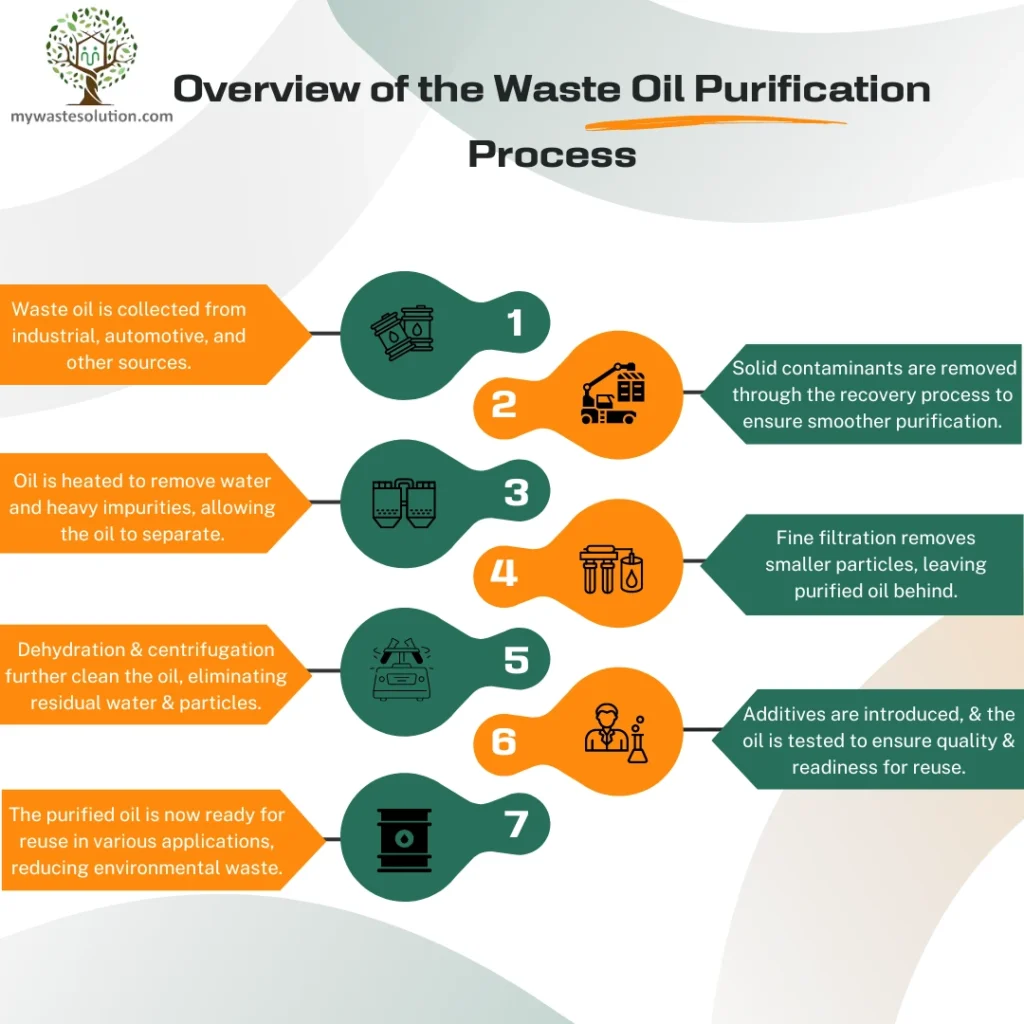
3. Acids in Waste Oil Purification
Acids play a key role in waste oil purification, enhancing oil quality:
- Sulfuric Acid: Vital for removing harmful compounds, sulfur-based impurities, and contaminants. Its strong acidic nature also helps refine metals, ensuring a high-quality oil product.
- Glacial Acetic Acid: A more equipment-friendly option, this acid is an effective solvent for purifying organic materials with minimal damage to machinery, unlike sulfuric counterparts.
- Formic Acid: Known for its cleaning properties, this solution works as a coagulant, efficiently separating contaminants from engine oils, enhancing usability and restoring their value.
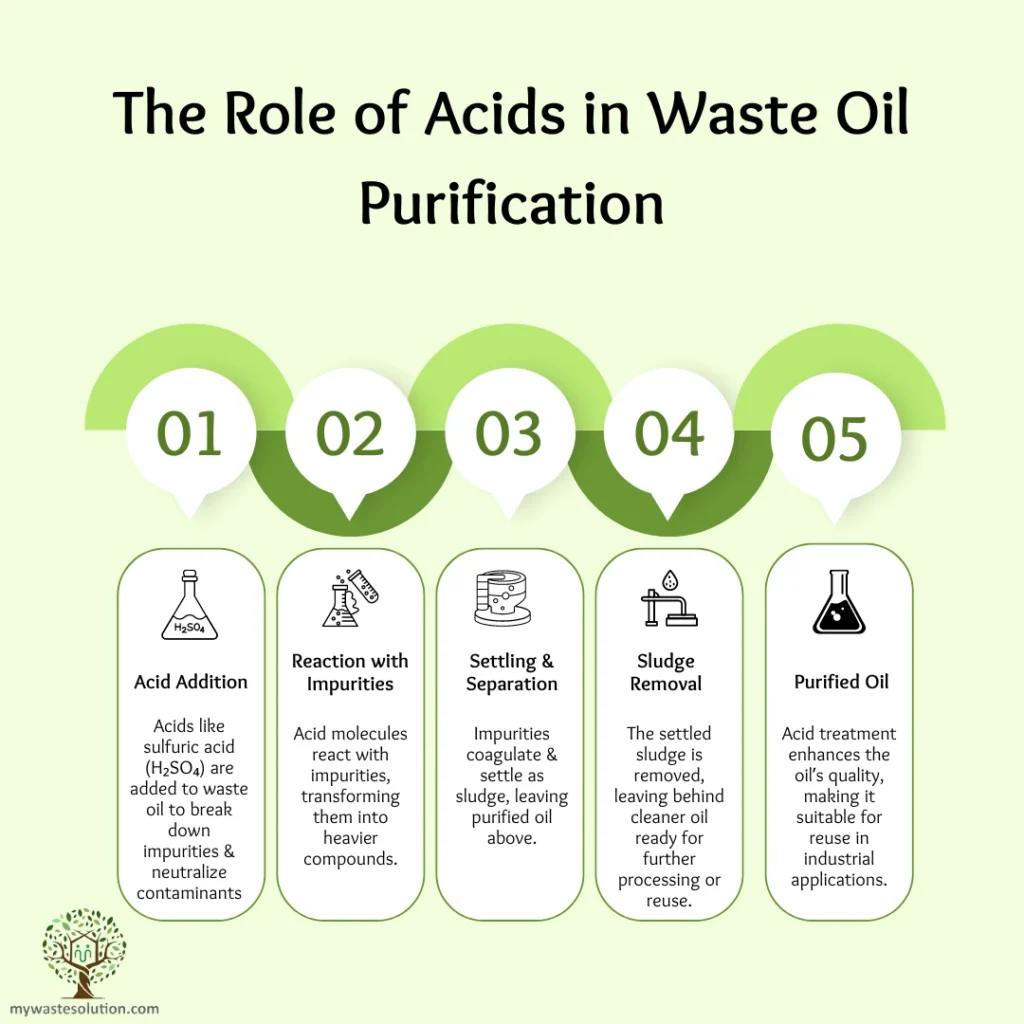
4. Proper Disposal of Used Cooking Oil
Proper disposal of used cooking oil is crucial to maintain a clean environment and prevent plumbing issues. Follow these steps:
- Cool and Contain: After cooling, transfer the frying liquid into a sealed container to prevent spillage, then dispose of it in the trash—never pour it down the drain.
- Reuse or Reprocess: Reusing or recycling the cooking oil can help reduce waste, but avoid pouring it into sinks, which can cause fatbergs and lead to costly plumbing repairs.
- Absorbent Disposal: Mix the liquid with materials like sand or paper towels before disposing of it with regular trash.
- Eco-Friendly Approach: Partner with companies that specialize in used oil collection for sustainable recycling and purification.
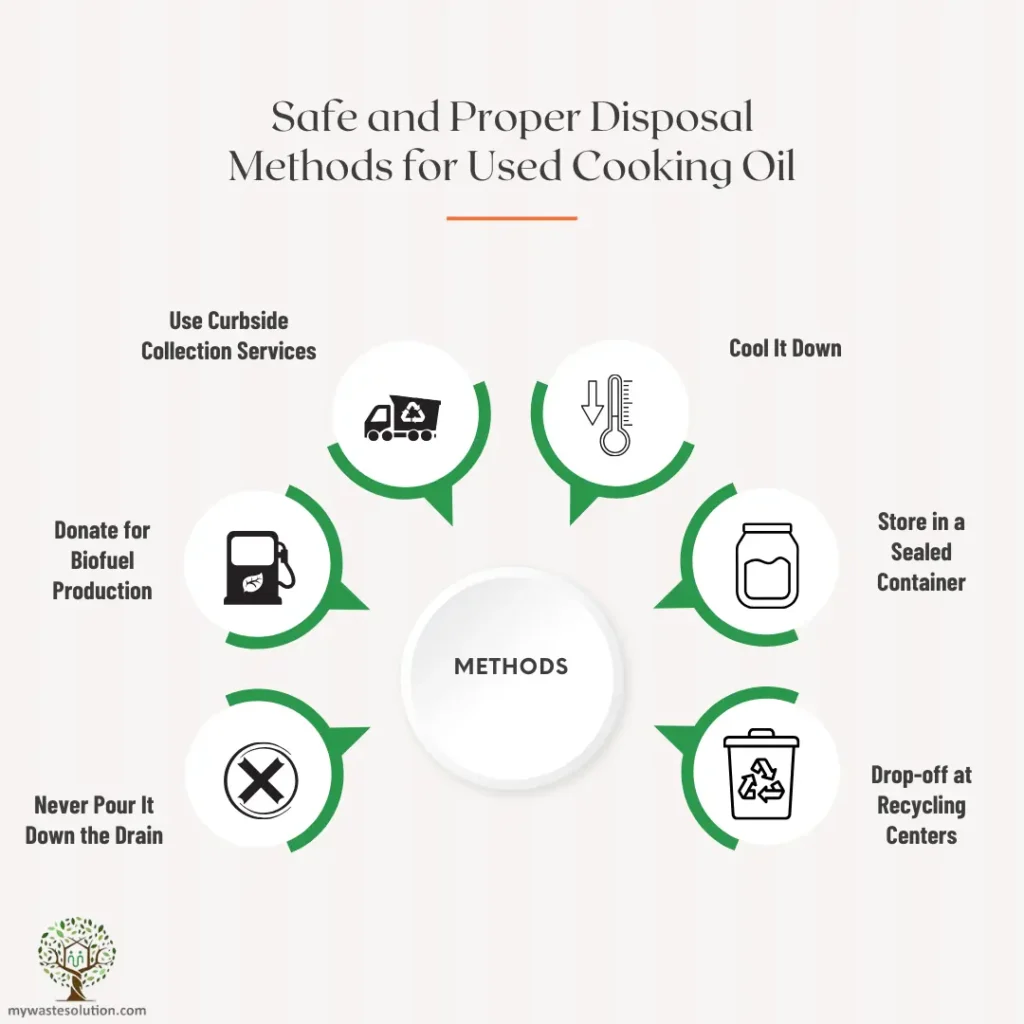
5. Waste Oil Cleaning Agents
Effective waste oil purification depends on specialized purification solutions such as kaolin clay, butanol, and potassium hydroxide (KOH), all recognized for their effectiveness in processing recycled oils. The optimal approach involves utilizing 30 mL of butanol, 3.0 g of KOH, and 1.5 g of kaolin. This combination triggers chemical reactions and adsorption to substantially lower the metal content in used lubricating fluids, resulting in cleaner, higher-quality output. These solutions offer a cost-efficient, reliable way to enhance lubricant refinement, improving the overall sustainability and productivity of the process.
Struggling with waste oil purification needs? Connect with top consultants specializing in waste oil purification solutions.
Connect Now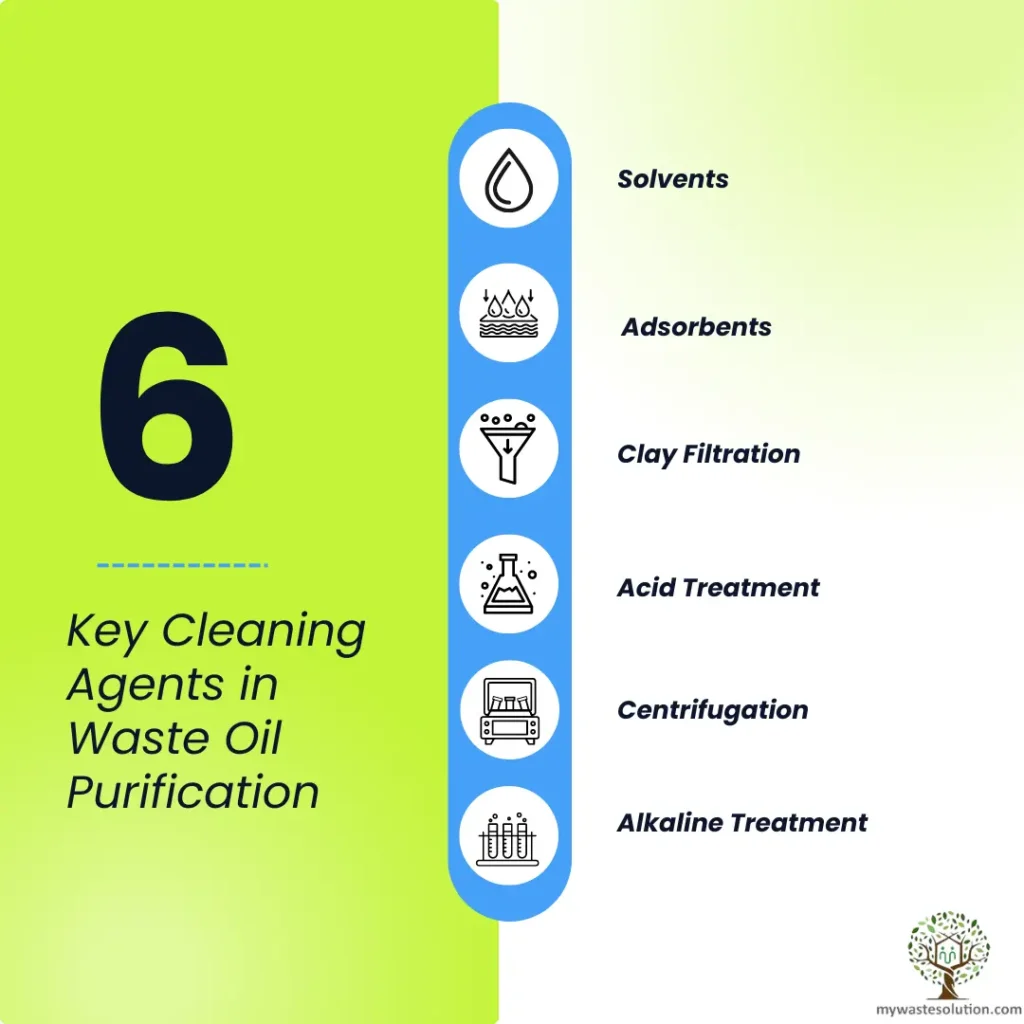
6. Waste Oil Pricing Trends
Used oil holds significant market value, though prices vary based on location and company. For those interested in buying or selling recycled lubricant, platforms like Indiamart, Petrol Bazaar, Exporters India, and Alibaba offer competitive pricing options. These systems serve both industries and households involved in waste oil purification and recycling, providing reliable access to Industry trends and opportunities for cost-effective transactions.
| Type of oil | Prices (may varies) |
| Waste tyre oil | ₹ 47/ Liter |
| Industrial waste oil | ₹ 40/ Liter |
| Used engine oil | ₹ 40/ Liter |
| Recycled used oil | ₹ 60/ Liter |
| Black used waste oil | ₹ 40/ Liter |
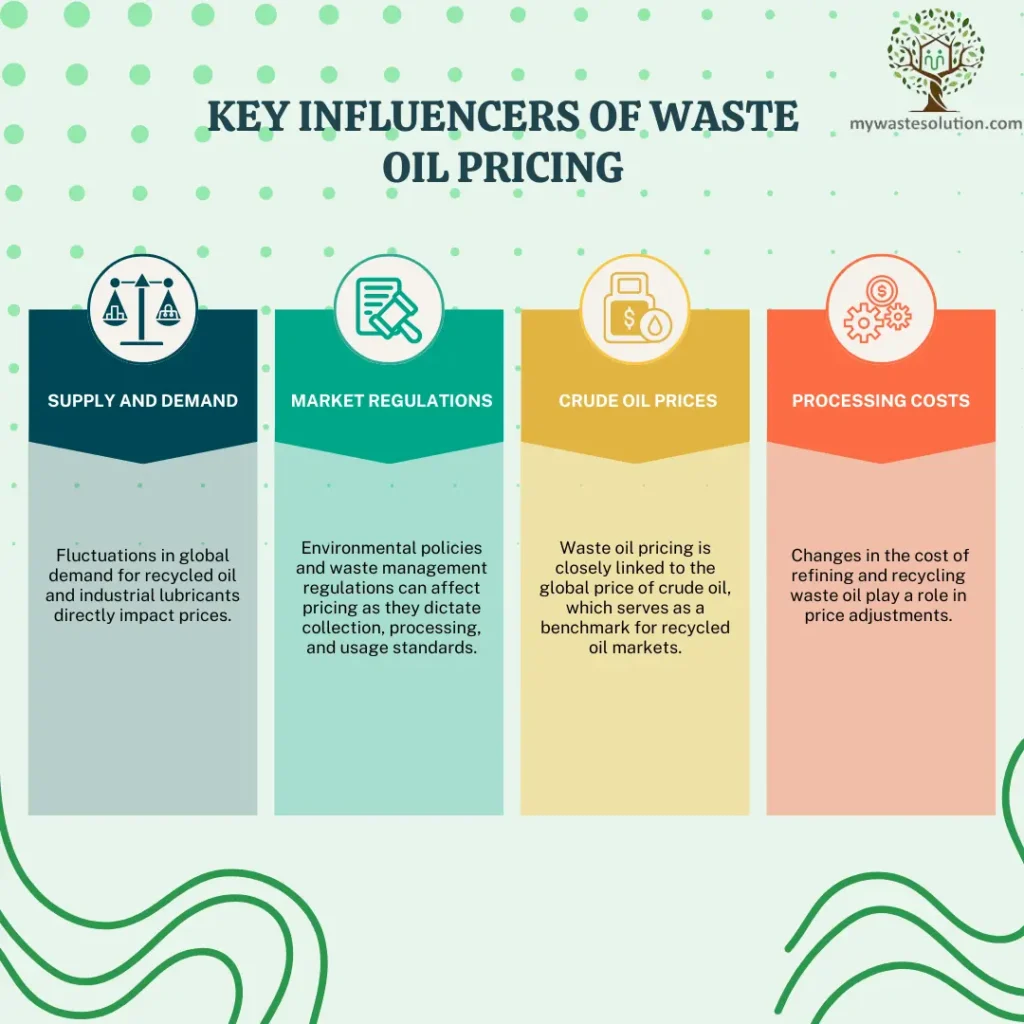
7. Waste Oil Purification Systems
The waste oil purification system setup varies based on specific requirements and cost-efficiency. Choosing the right equipment is critical to ensure effective oil purification, allowing us to optimize resources while reducing the environmental impact.
System 1: Vacuum Hydraulic Oil Dehumidifier/Waste Oil Purification Machine
Our Waste Oil Purification system utilizes a Vacuum Hydraulic Oil Dehumidifier to effectively remove water, gas, mechanical impurities, and hazardous substances from used lubricant. This process significantly enhances oil quality and restores its lubricating properties, ensuring smooth equipment operation. Additionally, with a discoloring framework, this machine can recover the oil’s color, further improving its usability and efficiency.
Find and connect with leading companies specializing in waste oil purification solutions.
Get Connected Today
System 2: DTS Multifunctional Waste Oil Purification & Regeneration Equipment
Our DTS Multifunctional Waste Oil Purification & Regeneration Equipment efficiently recycles all types of used lubricating and fuel oils. This advanced system offers four key functions: dehydration, decolorization, cleaning, and degassing, working together to transform dirty black oil into clean, yellow oil.
Additionally, the strainer tank features four purifier plates, reducing the need for frequent strainer replacements common in conventional filter machines.
System 3: Waste Cooking Oil Recycling Filter Machine
Our Waste Cooking Oil Recycling Filter Machine effectively cleans used cooking oil and stores it in a 75-liter tank, facilitating easy and hygienic transportation within the kitchen. Utilizing innovative vacuum filtration technology, this machine keeps particles dry inside the Purifier for superior performance.
Like all VITO oil filter systems, it offers microfiltration down to 5 µm, ensuring high-quality oil purification. Additionally, the unique design of the XM model withstands temperatures up to 200 °F, preventing direct contact with hot oils and promoting safe working practices.
System 4: Waste Oil Recycling Plant
Our Waste Oil Recycling Plant is engineered with advanced technical specifications and cutting-edge technology, ensuring low power consumption while maintaining a robust structure. With a fuel oil capacity of 1 to 5 tons per day, this plant provides an efficient solution for recycling waste oil.
System 5: Vacuum Dehydration Oil Purification Systems (VDOPS) Oil Purifier
Our Vacuum Dehydration Oil Purification Systems (VDOPS) effectively manage flow rates ranging from 3 GPM to 50 GPM or higher. This system excels at water removal, achieving an overall water content as low as 20 PPM through a multi-pass process that eliminates free, emulsified, and dissolved water.
Additional Features:
It ensures particulate removal, resulting in very low particle counts. The system also provides entrained air and gas removal through degassing by vacuum distillation. Equipped with fuller earth or activated alumina cartridges, it neutralizes acids and effectively removes insoluble varnish.
System 6: Portable Oil Filtration System
Our Portable Lubricant Filtration System features a vacuum lubricant filter machine that efficiently separates contaminants, including metal impurities, carbon residues, colloids, and both suspended and emulsified matter from freshly produced oil. This system serves as an excellent companion for oil press machines, enhancing the overall efficiency and cleanliness of the lubrication process.
Oil Property Restoration:
Additionally, it effectively restores physicochemical properties—such as viscosity and pH—of fried cooking oil, making it comparable to new oil. This versatile system is suitable for purifying all types of edible oils.
System 7: Heavy Fuel Waste Oil Purification Centrifuge Separator Machine
Our Heavy Fuel Waste Oil Filtration Centrifuge Separator Machine is engineered for efficient used oil purification. This automatic slagging model guarantees high separation efficiency without the need for disassembly during the slagging process.
Automation and Efficiency:
We incorporate automated controls tailored to specific requirements, significantly reducing labor intensity. With precise calibration and minimal vibration, this machine is designed for long-term operation, ensuring safety and reliability. Ultimately, it becomes a valuable asset for effective oil recycling.
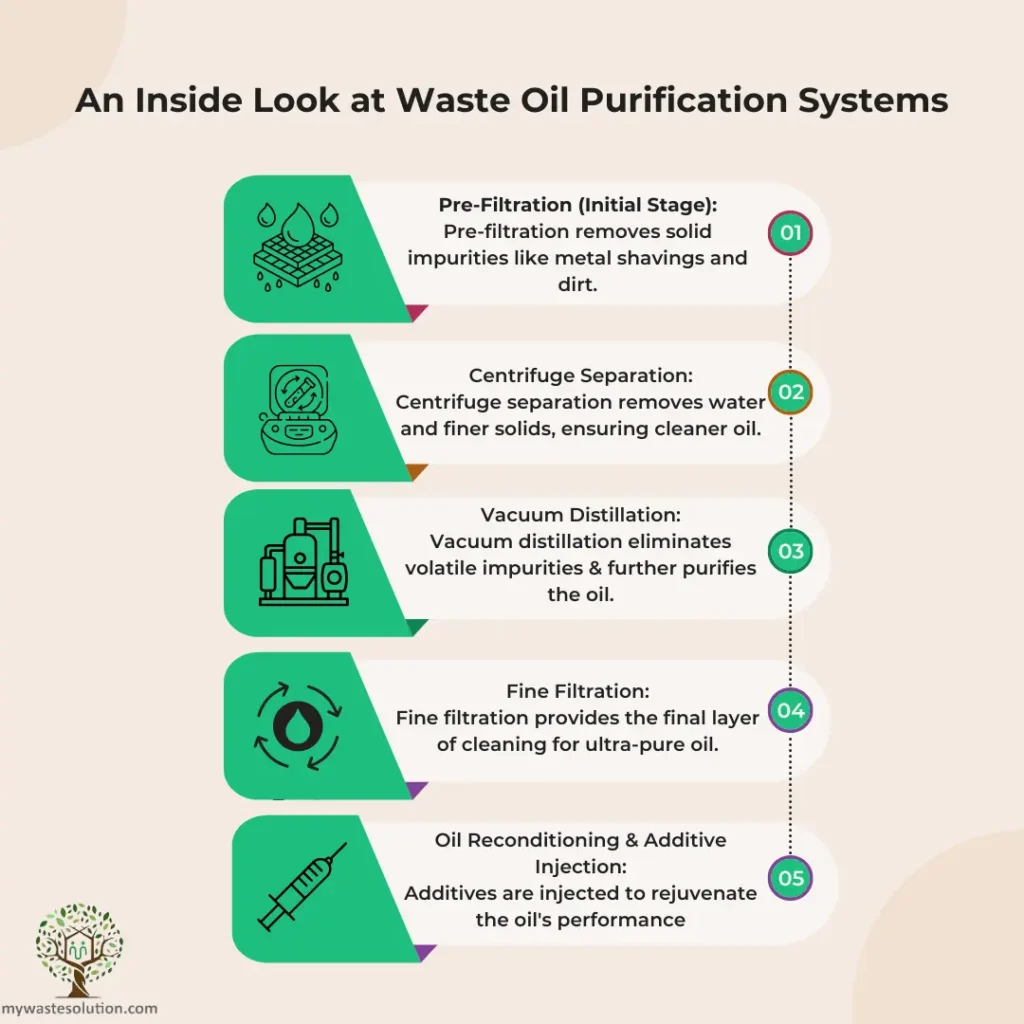
8. Processes for Waste Oil Purification
The waste oil purification process varies based on the types and levels of contaminants or additives present. Basic methods can eliminate mechanical impurities, while more advanced chemical procedures are needed to handle foreign materials effectively. Below, we outline the most efficient methods for refining recycled lubricants.
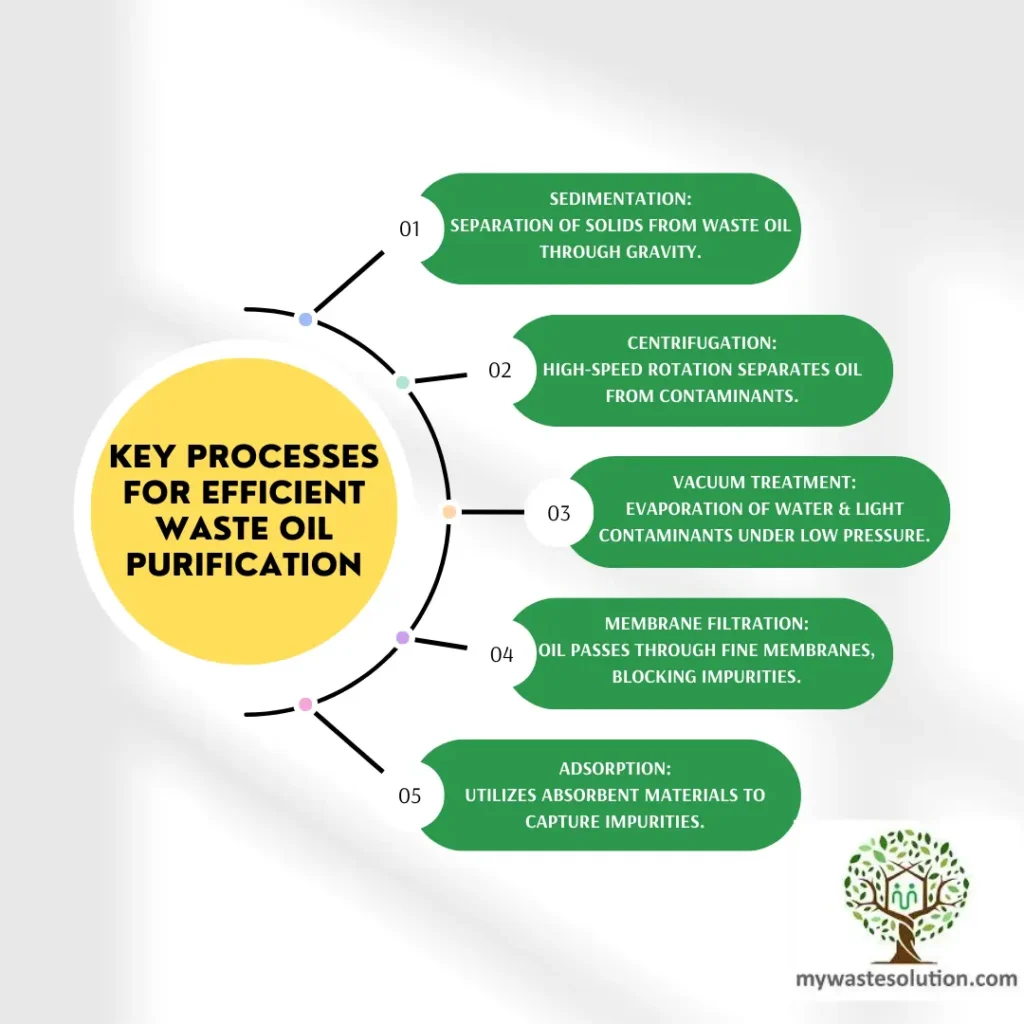
8.1 Sedimentation:
Sedimentation involves allowing heavy solid particles to naturally settle at the bottom of the lubricant. However, some particles remain suspended due to the presence of dispersing additives, commonly found in diesel-based and automotive fluids. These additives play a crucial role in improving fluid performance and extending its shelf life, ensuring continued effectiveness over time.

Explore the best waste oil treatment and recycling machinery and equipments for your industrial needs.
Connect Today8.2 Vacuum Treatment:
In the vacuum treatment process, we effectively extract dissolved water from the fluid. First, we heat the lubricant and pass it through a vacuum column, maximizing the surface area for the separation of vapors and gases. This method is vital for delivering high-quality results in our waste oil purification system, offering significant benefits to industries and households looking to buy, sell, or utilize refined fluids.
Fig: Waste oil distillation plant.
8.3 Adsorption Method:
In the adsorption method, an adsorbent retains impurities on its surface, effectively eliminating contaminants. While some adsorbents are artificially created, bleaching clay is a notable natural option known for its efficacy. This technique is vital in waste oil purification, significantly enhancing the quality of recycled oils.
8.4 Membrane Filtration:
Membrane filtration is a continuous approach that improves the fluidity and flash point of recovered fluids by effectively removing metal and dust particles from spent engine oil. We recycle used motor oil using three types of polymer hollow fiber membranes: polyethersulfone, polyvinylidene fluoride, and polyacrylonitrile. This method operates at low pressure and a temperature of 40 °C. Although modern high-temperature polymeric membranes offer significant advantages over traditional oil re-refining techniques, they are generally more expensive and susceptible to damage from larger particles.
8.5 Acid Treatment:
Acid treatment involves treating used engine fluids with various acids, followed by clay absorption. Since 1935, sulfuric acid treatment technology has been a popular method for fluid recovery. Initially, the used oil is filtered to eliminate mechanical impurities and then distilled to remove water and lighter fractions. Sulfuric acid dissolves aromatic compounds, soot, and other impurities, creating residues that can be easily separated. The recovered fluid is subsequently clarified with bentonite clay. However, this method has become less common due to the toxic waste it produces, complicating waste management.
8.6 Solvent Extraction:
Solvent extraction is a technique we use to dissolve undesirable aromatic components in a solvent while preserving the desired saturated hydrocarbons, particularly alkanes, in a separate phase. The process begins with us filtering the used oil to remove solid residues. Next, we combine the filtered liquid with the solvent, allowing a settling tank to separate the lighter stream containing the lubricating oil fraction and solvent from the heavier underflow, which includes heavy metal compounds and asphaltic debris. We then apply a distillation process to recover the solvent, resulting in a stream primarily composed of lubricating fluid, which we can further separate in a fractionating column using a vacuum. Common solvents we use in this technique include propane, butane, and pentane.
8.7 Clay Treatment:
In the oil filtration method, we start with pretreatment to remove contaminants that may cause fouling and equipment corrosion. This is followed by distillation, separating water and light hydrocarbons, and vacuum distillation using either a thin film or a traditional vacuum column. After these stages, we treat the product with activated clay to eliminate unwanted color, odor, and other undesirable components. A significant advancement in this technique is the regeneration of used clay, enabling it to be recycled for multiple treatments before replacement. This innovation enhances efficiency and supports sustainable waste oil purification practices.
Fig: Used/ Waste Oil re-refining process
9. Regulations for Used Oil Filter Disposal
Used oils and waste oils are classified as hazardous substances and must be sent to a registered recycling or refining unit. It’s vital to collect these oils in proper containers for safe disposal, avoiding any dumping on the ground, into sewers, or in dumpsters.
Struggling with bio-fuel buying and selling issues? Connect with bio-fuel buyers and sellers here.
Buyer Listings Seller ListingsSpecifications for waste lubricant suitable for recycling include:
- Sediments: 5% max
- Heavy metals: 605 ppm max
- PAH (Poly Aromatic Hydrocarbons): 6% max
- PCBs (Polychlorinated Biphenyls): Below detection limit
- Halogens: 4000 ppm max (total halogens)
Spent oil that does not meet these criteria cannot be sold but can be disposed of in an incinerator equipped with an air pollution control device, ensuring emissions remain within legal limits. Conversely, compliant spent oil can be sold through authorized dealers.
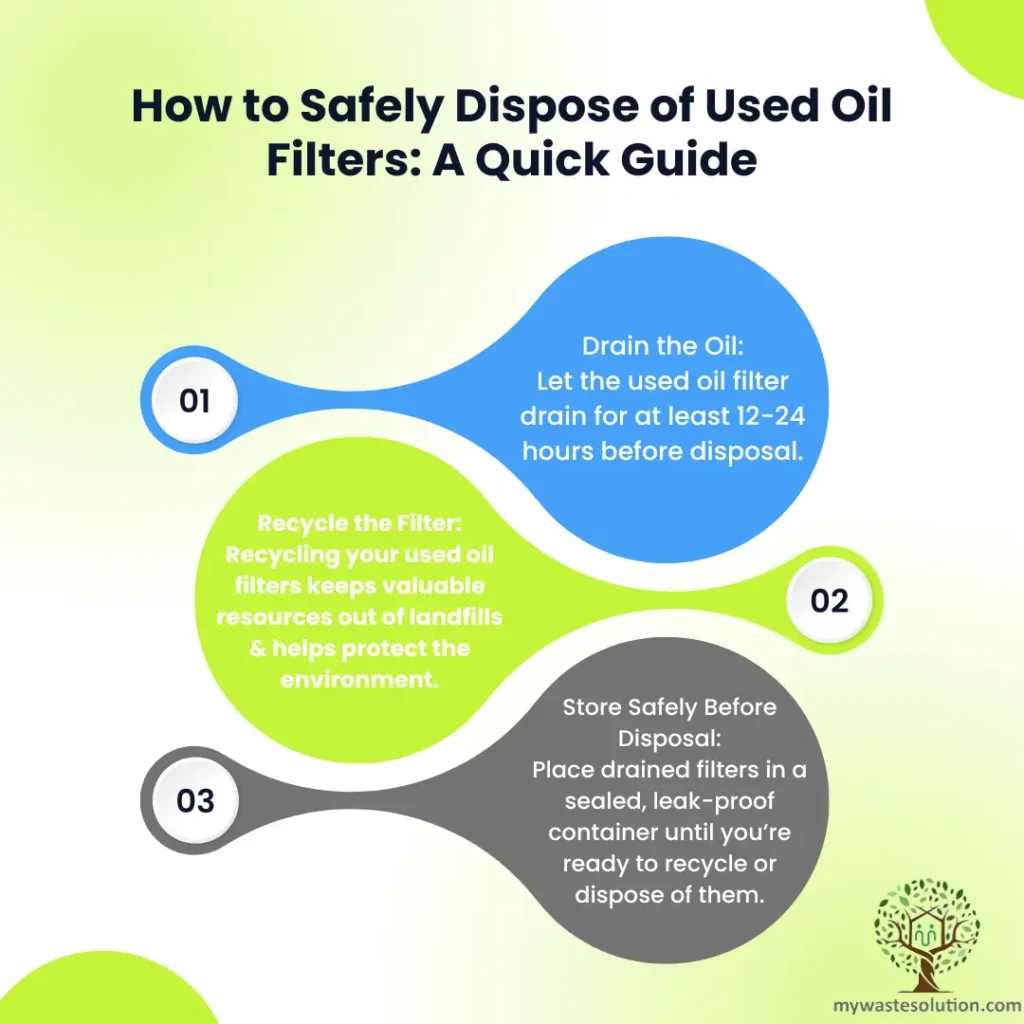
There are specific registration procedures for the disposal and recycling of used lubricants and waste oils, detailed in the principal rules issued by authorities. Forms vary for recyclers and those selling used and Recycled oils. It is strongly recommended that recyclers and refiners utilize only environmentally sound technologies to ensure safe and compliant disposal.
10. Is Waste Oil Hazardous?
Used oil and waste oil are classified as hazardous materials according to the Hazardous Waste Management and Handling Rules, 2008. These fluids fall under the category of “Hazardous Waste for Recycling.” Various sectors are provided with Environmentally Sound Technology (EST) guidelines for the recycling of hazardous substances, ensuring that the recycling process is both efficient and environmentally safe.
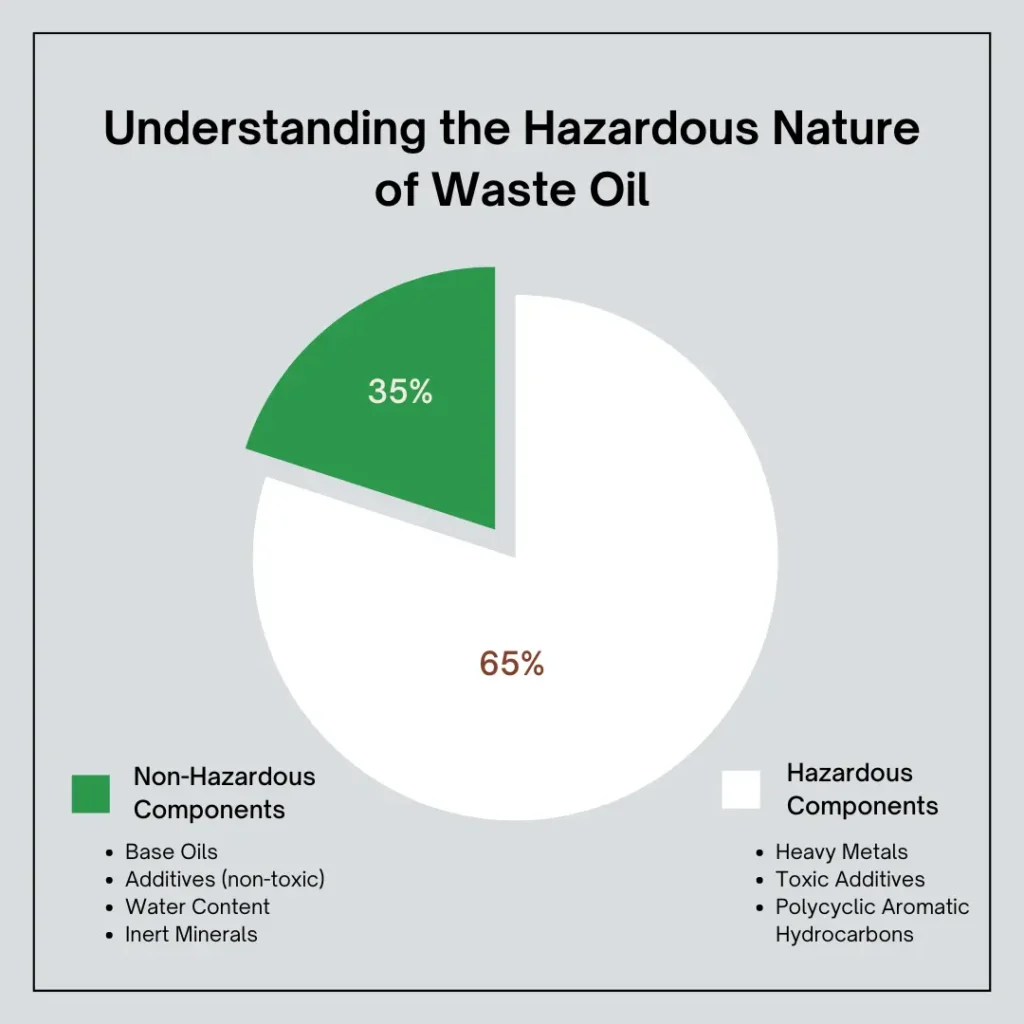
10.1. Reprocessing & Re-Refining of Used Oil:
Under the Hazardous Waste Management and Handling Rules, 2008, recycled oils that meet recycling specifications can be reprocessed and re-refined. The re-refining process effectively removes contaminants such as diluents, water, additives, dirt, heavy metals, and sediments. Discarded oil encompasses spills of crude petroleum, bottom sludges, and slop fluids generated from petroleum installations and refineries. This lubricant can be used for energy recovery if it meets specific criteria for consumption as fuel. The following Environmentally Sound Technologies (ESTs) are approved for discarded oil recycling:
- Vacuum distillation with clay treatment: A widely used technology in India.
- Vacuum distillation with hydrotreating: Effective but less common due to high investment costs.
- Thin film distillation: Another preferred method for reprocessing discarded lubricants.
Used Oil Treatment: Vacuum Distillation & Clay Treatment:
Vacuum distillation can be conducted with either clay treatment or hydro-treating, depending on industry needs. The key steps in this process include:
- Pretreatment: This step separates suspended matter from the utilized lubricant using methods like screen gravity settings to remove particles. The utilized fluid is screened before transportation, and removed sediments must be disposed of as hazardous waste, following SPCB/PCC authorization.
- Dehydration: To eliminate water content, the fluid is heated to 100-120°C. The resulting water vapor must be condensed, treated, and disposed of according to environmental standards.
- De-fueling: This process requires temperatures of 120-300°C and a pressure of around 200 mm Hg to remove the fuel fraction from the utilized lubricant. Although this fraction may still contain traces of water, it can be repurposed as fuel for boilers or furnaces.
- Lube-based Stock Separation: After removing water and fuel fractions, lube-based fluid is separated through further distillation at 350°C and pressures of 40-50 mm Hg. Lower pressures, like 40 mm Hg, can also be used with a jacketed hollow column. The spent clay from this process can be discarded or repurposed as fuel or in cement production through co-processing.
11. Recycling Waste Oil
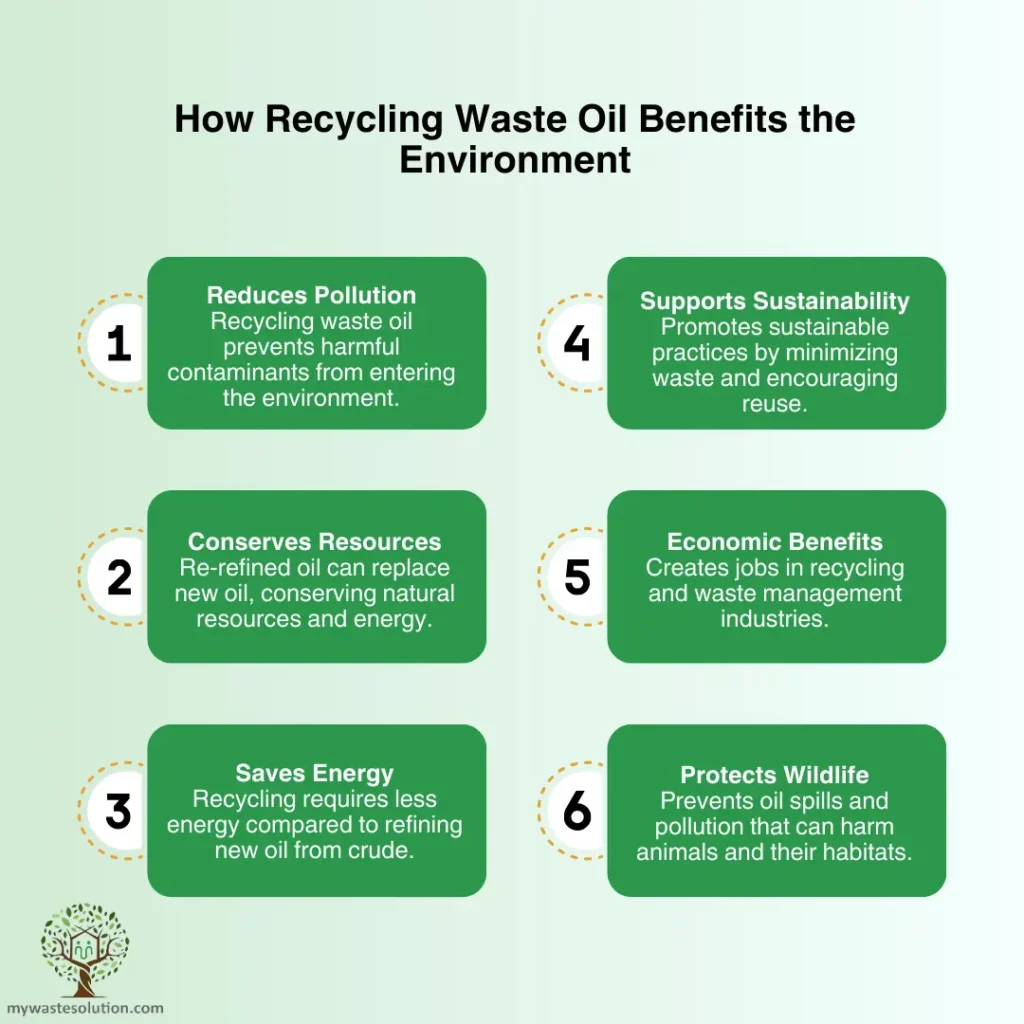
Used oil, as defined by hazardous waste management rules, includes spills of crude oil, storage tank sludge, and industrial oil spent from various sectors, including refineries. Key sources of this waste include ship ports, bulk furnace oil facilities, and refinery operations. Many ports conduct auctions to register oil recycling companies, while refineries either recycle internally or send their oil waste to specialized reusing plants. The sludge generated from this process is often repurposed for use in cement kilns and energy production, following guidelines from the CPCB. The recycling process focuses on removing contaminants such as sediments, metals, and water.
Fig: option for waste oil purification
India has approximately 257 registered oil reprocessing plants spread across 124 districts in 19 states. Maharashtra leads with 16%, followed by Gujarat at 14%. Although the recycling potential is substantial, challenges persist due to the high costs associated with collection, storage, and disposal.
Used Lubricant Oil Recycling Process:
Previously, used lubricating oils were mainly incinerated for energy recovery. Over time, these oils began to be re-blended into engine oils following treatment. As the demand for environmental protection has increased, proper disposal and recycling of spent oils have become crucial. The recycling process employs several techniques, including vacuum distillation, acid treatment, adsorption, and filtration. For a comprehensive overview, refer to the section on waste oil purification methods.
12. Benefits of waste Oil Purification
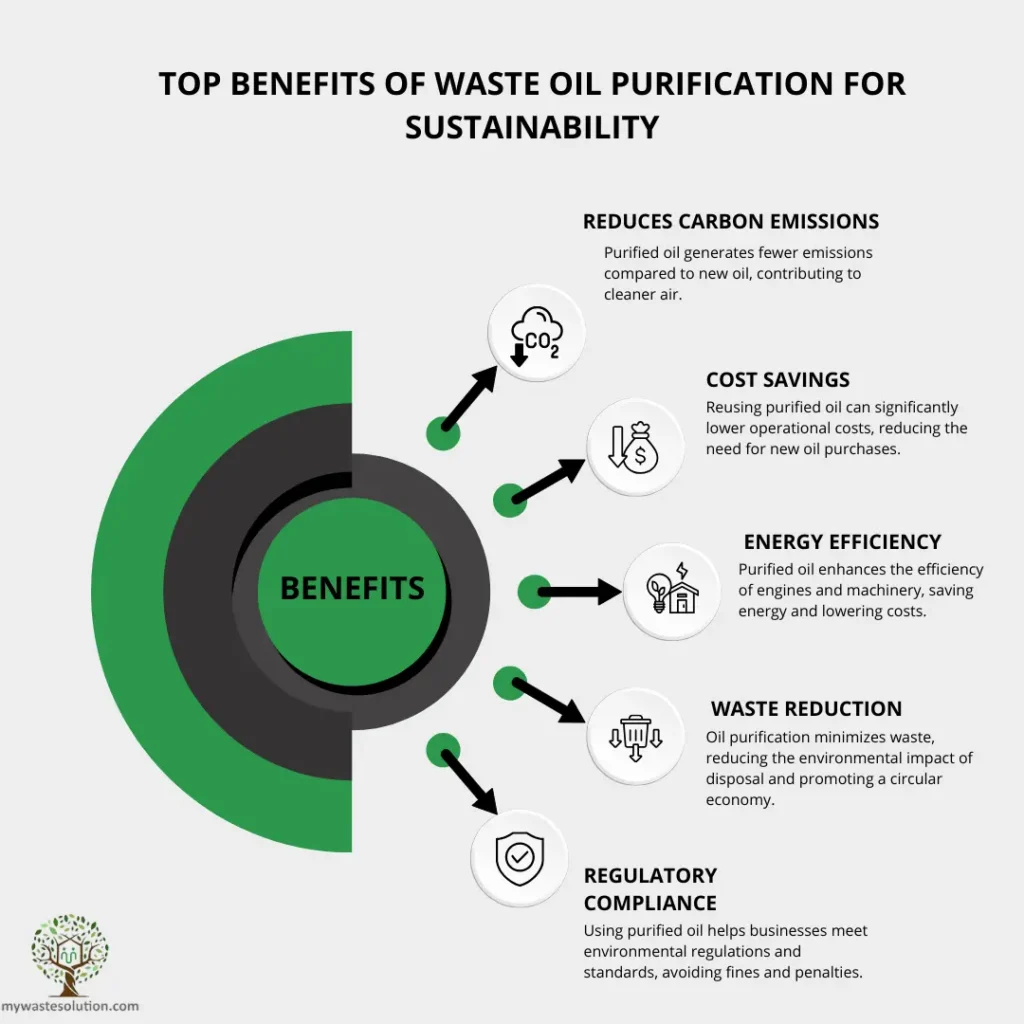
12.1. Supports Sustainability Efforts:
A key advantage of waste oil purification is its significant promotion of sustainability. By minimizing resource use and maximizing efficiency, we preserve valuable assets for future generations. Adopting processes that generate little to no waste reduces environmental harm. Choosing eco-friendly methods protects our environment and supports long-term sustainable practices for both industries and households.
12.2. Reduces Carbon Emissions:
Oil purification offers major benefits, including eliminating the need for landfilling. Purifying and reusing spent oil prevents environmental pollution caused by landfills. Instead of discarding it, we can repurpose it for energy generation, producing heat, creating plastics, and powering motors. These advantages make waste oil purification a smart, sustainable choice for industries and households.
12.3. Eliminates Landfilling Needs:
Waste oil purification offers major benefits, including eliminating the need for landfilling. Purifying and reusing waste oil prevents environmental pollution from landfills. Instead of discarding, we can repurpose it for energy generation, producing heat, creating plastics, and powering oil motors. These advantages make waste oil filtration a smart, sustainable choice for industries and households.
12.4. Encourages Innovation:
Exciting innovations are transforming waste oil purification by converting used cooking oil, engine oil, and motor oil into renewable alternatives. These sustainable fuels can power diesel engines, operate machinery, and heat buildings. Advancements also enhance treatment, recycling processes, and purification methods, attracting stakeholders from both public and private sectors. To explore these opportunities, check for Authorized Spent Oil preprocessors in Maharashtra.
12.5. Cost Savings:
Oil filtration offers substantial savings on disposal fees, liability costs, and heating expenses. By opting for recycling instead of draining spent oil, we can prevent pipe damage and avoid costly repairs. Remind family members to recycle cooking oil to save money and support eco-friendly practices. This sustainable habit benefits both our finances and the environment.
12.6. Minimizes Pollution Risks:
Waste oil purification significantly reduces pollution risks by recycling plastic waste and recycled cooking oil, preventing harmful contaminants from entering waterways. Minimizing landfill use also helps protect groundwater from pollutants. Additionally, utilizing recycled materials decreases dependence on virgin resources, leading to lower greenhouse gas emissions. This approach conserves resources and contributes positively to the environment.
13. Challenges in Waste Oil Purification
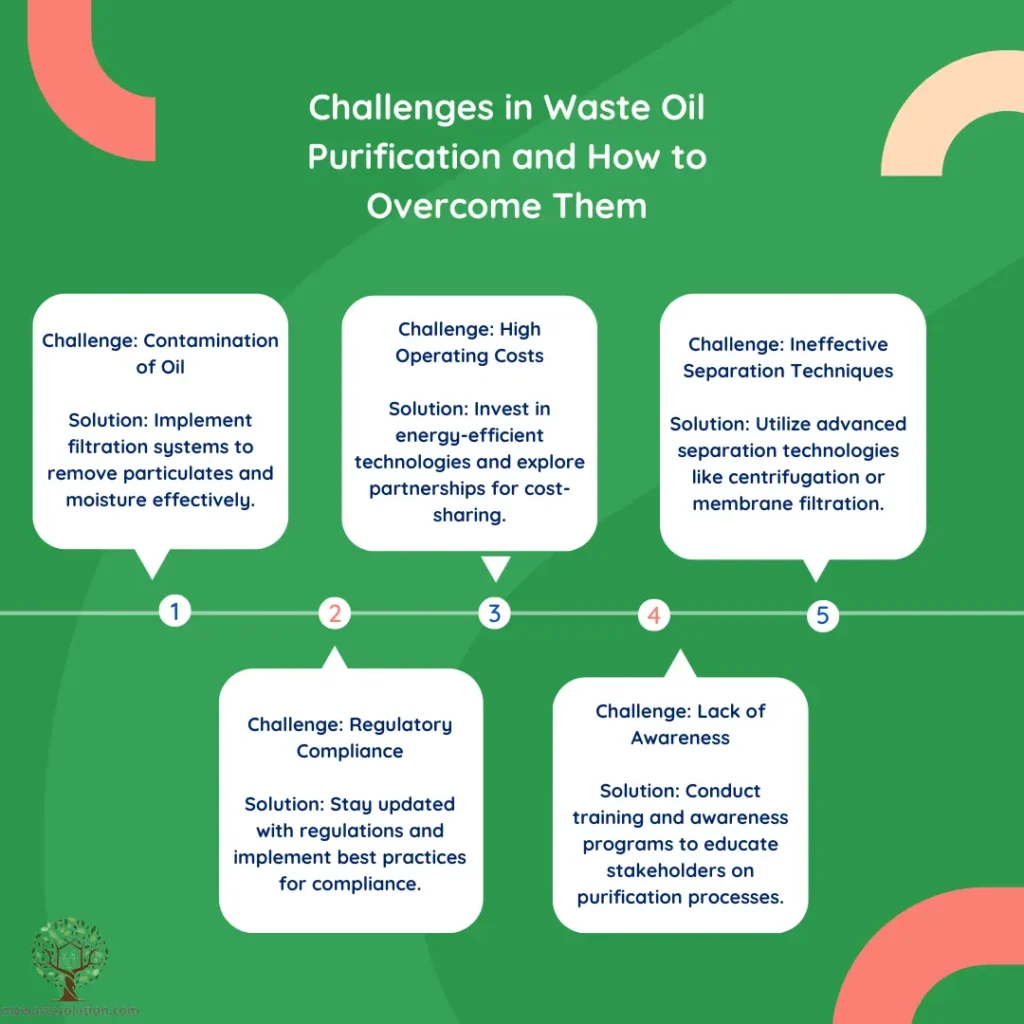
13.1 Storage and Transport
Managing the collection and transport of used oils can be expensive, especially for the control unit overseeing maintenance. Regular upkeep is vital for smooth operations but increases costs. Interstate restrictions often complicate logistics, impacting both used oil recycling and overall management of spent oils. Tackling these challenges can streamline the trade of recycled fluids for industries and households.
13.2 Advanced Technologies
Implementing advanced technologies like vacuum filtration with hydrotreating can be costly and requires skilled operators. Techniques such as pyrolysis are energy-intensive and often demand additional water and chemicals, increasing operational complexity. While these innovations enhance the recycling process, their cost and resource demands are key considerations for industries and households.
13.3 Handling Hazardous Byproducts
Waste oil purification methods produce hazardous byproducts, complicating the overall procedure. For instance, solvents can turn simple compounds into toxic ones, unsuitable for commercial use. Techniques like incineration and hydrotreating contribute to environmental pollution and create sludge disposal challenges. Similarly, clay and acid treatments generate acid-based sludge, classified as hazardous waste, requiring special handling.
13.4 Health Risks
In waste oil purification, small units without proper safety precautions expose workers to health risks. Prolonged exposure to fumes from waste lubricants can lead to severe conditions like pulmonary fibrosis and emphysema. To protect workers’ health, industries and households must enforce strict safety measures.
13.5 Awareness Issues
Many believe that waste oil filtration is highly hazardous, but advanced technologies allow for safe handling. A lack of awareness limits the adoption of these methods. When transferring waste lubricants to a third party, verifying their credentials is crucial to prevent misuse in the black market. By promoting awareness and responsible practices, we can ensure safe, ethical disposal and purification methods that benefit industries and the environment.
